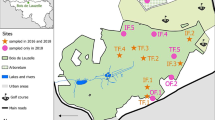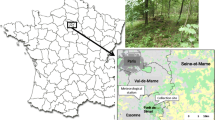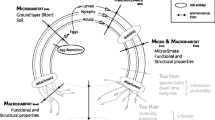Abstract
Ticks are important ectoparasites and vectors of pathogens that cause disease in humans and animals. The natural habitat of Ixodes ricinus ticks is forests, which are convenient habitats to search for hosts, including reservoir hosts, and therefore can be an important habitat source of tick-borne pathogens. The aim of the study was to assess the usefulness of detailed forest habitat-type maps to estimate the tick-borne risk at a local scale (Lower Silesia, SW Poland). For the purposes of estimating tick abundance, we used the land cover maps available from the Forest Data Bank. For I. ricinus collection, nine sites located in three forest habitat types were chosen: broadleaf forest, mixed broadleaf and coniferous forest and coniferous forest. Ticks were collected once a month from April to June 2018 and 2019 using the standard flagging method. At each of the nine sites, ticks were collected in four plots, of 100 m2 each. Tick abundance was analysed using general linear mixed models (GLMM). A total of 2196 (10.1/100 m2) ticks were collected, including 2093 Ixodes ricinus (95.3%; 9.6/100 m2), 46 Dermacentor reticulatus (2.1%; 0.2/100 m2) and 57 Haemaphysalis concinna (2.6%; 0.3/100 m2). Among the collected I. ricinus were 589 larvae (28.1%; 2.7/100 m2), 1261 nymphs (60.3%; 5.8/100 m2), 128 females (6.1%; 0.6/100 m2) and 115 males (5.5%; 0.5/100 m2). We found a highly significant effect of forest habitat type on the density of ticks for broadleaf forest (coefficient = 1.87267, p-value = 2.79e − 07). Additionally, a significant influence of air temperature and relative humidity on the abundance of ticks was observed. During spring, the peak activity of I. ricinus was recorded in May and June. For DNA amplification of Borrelia burgdorferi s.l., a nested PCR method was used. Out of 494 I. ricinus, 83 (16.8%) were positive for Borrelia spp. The RFLP method showed the occurrence of five species including four belonging to the B. burgdorferi s.l. complex: B. afzelii (30.1%), B. garinii (38.6%), B. valaisiana (2.4%) and B. lusitaniae (18.1%). Furthermore, B. miyamotoi (9.6%), a species belonging to bacteria that cause relapsing fever as well as co-infection of B. miyamotoi/B.lusitaniae (1.2%) were found. The differences in the infection level of Borrelia spp. between broadleaf forest and mixed broadleaf and coniferous forest were statistically significant.




Similar content being viewed by others
References
Andreassen A, Jore S, Cuber P, Dudman S, Tengs T, Isaksen K, Hygen HO, Viljugren H, Ånestad G, Ottesen P, Vainio K (2012) Prevalence of tick borne encephalitis virus in tick nymphs in relation to climatic factors on the southern coast of Norway. Parasit Vector 5:1–12. https://doi.org/10.1186/1756-3305-5-177
Barandika JF, Berriatua E, Barral M, Juste RA, Anda P, Garcia-Perez AL (2006) Risk factors associated with ixodid tick species distributions in the Basque region in Spain. Med Vet Entomol 20:177–188. https://doi.org/10.1111/j.1365-2915.2006.00619.x
Boehnke D, Gebhardt R, Petney T, Norra S (2017) On the complexity of measuring forests microclimate and interpreting its relevance in habitat ecology: the example of Ixodes ricinus ticks. Parasit Vectors 6:549. https://doi.org/10.1186/s13071-017-2498-5
Bolker BM, Brooks MF, Clark CJ, Geange SW, Poulsen JR, Stevens MH, White JS (2009) Generalized linear mixed models: a practical guide for ecology and evolution. Trends Ecol Evol 24:127–135
Braks MA, Mulder AC, Swart A, Wint W (2016) Gras** risk map**. In Braks, vanWieren, Takken and Sprong (eds), Ecology and prevention of Lyme borreliosis [en ligne], Wageningen (Pays-Bas): Wageningen Academic Publishers, pp. 351–371. https://doi.org/10.3920/978-90-8686-838-4_25
Cisak E, Chmielewska-Badora J, Zwoliński J, Wójcik-Fatla A, Polak J, Dutkiewicz J (2005) Risk of tick-borne bacterial diseases among workers of Roztocze National Park (south-eastern Poland). Ann Agric Environ Med 12:127–132
Dantas-Torres F, Chomel BB, Otranto D (2012) Ticks and tick-borne diseases: a one health perspective. Trends Parasitol 28:437–446. https://doi.org/10.1016/j.pt.2012.07.003
Dobson AD, Taylor JL, Randolph SE (2011) Tick (Ixodes ricinus) abundance and seasonality at recreational sites in the UK: hazards in relation to fine-scale habitat types revealed by complementary sampling methods. Ticks Tick Borne Dis 2:67–74. https://doi.org/10.1016/j.ttbdis.2011.03.002
Ehrmann S, Liira J, Gärtner S, Hansen K, Brunet J, Cousins SAO, Deconchat M, Decocq G, De Frenne P, De Smedt P, Diekmann M, Gallet-Moron E, Kolb A, Lenoir J, Lindgren J, Naaf T, Paal T, Valdés A, Verheyen K, Wulf M, Scherer-Lorenzen M (2017) Environmental drivers of Ixodes ricinus abundance in forest fragments of rural European landscapes. BMC Ecol 17:31. https://doi.org/10.1186/s12898-017-0141-0
Ehrmann S, Ruyts SC, Scherer-Lorenzen M, Bauhus J, Brunet J, Cousins SAO, Deconchat M, Decocq G, De Frenne P, De Smedt P, Diekmann M, Gallet-Moron E, Gärtner S, Hansen K, Kolb A, Lenoir J, Lindgren J, Naaf T, Paal T, Panning M, Prinz M, Valdés A, Verheyen K, Wulf M, Liira J (2018) Habitat properties are key drivers of Borrelia burgdorferi (s.l.) prevalence in Ixodes ricinus populations of deciduous forest fragments. Parasit Vectors 11, 23. https://doi.org/10.1186/s13071-017-2590-x
Estrada-Peña A (2001) Distribution, abundance, and habitat preferences of Ixodes ricinus (Acari: Ixodidae) in northern Spain. J Med Entomol 38:361–370. https://doi.org/10.1603/0022-2585-38.3.361
Estrada-Peña A, Mihalca AD, Petney NT (2017) Ticks of Europe and North Africa: a guide to species identification. Springer International Publishing. https://doi.org/10.1007/978-3-319-63760-0
Garcia-Marti I, Zurita-Milla R, Harms MG, Swart A (2018) Using volunteered observations to map human exposure to ticks. Sci Rep 8:15435. https://doi.org/10.1038/s41598-018-33900-2
Garcia-Marti I, Zurita-Milla R, van Vliet AJH, Takken W (2017) Modelling and map** tick dynamics using volunteered observations. Int J Health Geogr 16:41. https://doi.org/10.1186/s12942-017-0114-8
Gethmann J, Hoffmann B, Kasbohm E, Süss J, Habedank B, Conraths FJ, Beer M, Klaus C (2020) Research paper on abiotic factors and their influence on Ixodes ricinus activity-observations over a two-year period at several tick collection sites in Germany. Parasitol Res 119:1455–1466. https://doi.org/10.1007/s00436-020-06666-8
Gilbert L, Aungier J, Tomkins JL (2014) Climate of origin affects tick (Ixodes ricinus) host-seeking behavior in response to temperature: implications for resilience to climate change? Ecol Evol 4:1186–1198. https://doi.org/10.1002/ece3.1014
Gilbert L, Maffey GL, Ramsay SL, Hester AJ (2012) The effect of deer management on the abundance of Ixodes ricinus in Scotland. Ecol Appl 22:658–667. https://doi.org/10.1890/11-0458.1
Guy EC, Stanek G (1991) Detection of Borrelia burgdorferi in patients with Lyme disease by the polymerase chain reaction. J Clin Pathol 44(7):610–611. https://doi.org/10.1136/jcp.44.7.610
Hofmeester TR, Sprong H, Jansen PA, Prins HHT, van Wieren SE (2017) Deer presence rather than abundance determines the population density of the sheep tick, Ixodes ricinus, in Dutch forests. Parasit Vectors 10:433. https://doi.org/10.1186/s13071-017-2370-7
Hubálek Z, Halouzka J, Juřicová Z, Šikutová S, Rudolf I (2006) Effect of forest clearing on the abundance of Ixodes ricinus ticks and the prevalence of Borrelia burgdorferis.l. Med Vet Entomol 20:166–172. https://doi.org/10.1111/j.1365-2915.2006.00615.x
Jaenson TG, Jaenson DG, Eisen L, Petersson E, Lindgren E (2012) Changes in the geographical distribution and abundance of the tick Ixodes ricinus during the past 30 years in Sweden. Parasit Vectors 5:8. https://doi.org/10.1186/1756-3305-5-8
Jung Kjær L, Soleng A, Edgar KS, Lindstedt HEH, Paulsen KM, Andreassen ÅK, Korslund L, Kjelland V, Slettan A, Stuen S, Kjellander P, Christensson M, Teräväinen M, Baum A, Klitgaard K, Bødker R (2019) Predicting the spatial abundance of Ixodes ricinus ticks in southern Scandinavia using environmental and climatic data. Sci Rep 9:18144. https://doi.org/10.1038/s41598-019-54496-1
Kahl O (2018) Hard ticks as vectors—some basic issues. Wien Klin Wochenschr 130:479–483. https://doi.org/10.1007/s00508-018-1360-x
Karbowiak G, Biernat B, Szewczyk T, Sytykiewicz H (2015) The role of particular tick developmental stages in the circulation of tick-borne pathogens affecting humans in Central Europe. 1. The general pattern. Ann Parasitol 61:221–228. https://doi.org/10.17420/ap6104.11
Karbowiak G, Kiewra D (2010) New locations of Dermacentor reticulatus ticks in Western Poland: the first evidence of the merge in D reticulatus occurrence areas? Wiad Parazytol 56(4):333–340
Kiewra D (2014) Ocena wektorowej roli kleszczy Ixodes ricinus L. 1758 (Acari, Ixodidae) w transmisji krętków Borrelia burgdorferi s.l. na terenie Polski, ze szczególnym uwzględnieniem Dolnego Śląska. I-Bis ISBN: 978–83–615–12–44–8
Kiewra D, Czułowska A, Dyczko D, Zieliński R, Plewa-Tutaj K (2019) First record of Haemaphysalis concinna (Acari: Ixodidae) in Lower Silesia, SW Poland. Exp Appl Acarol 77:449–454. https://doi.org/10.1007/s10493-019-00344-w
Kiewra D, Stańczak J, Richter M (2014) Ixodes ricinus ticks (Acari, Ixodidae) as a vector of Borrelia burgdorferi sensu lato and Borrelia miyamotoi in Lower Silesia, Poland – preliminary study. Ticks Tick Borne Dis 5:892–897. https://doi.org/10.1016/j.ttbdis.2014.07.004
Kliczkowska A (2006) Siedliskowe podstawy hodowli lasu. Wydawnictwo "Świat", Warszawa
Kmieciak W, Ciszewski M, Szewczyk EM (2016) Tick-borne diseases in Poland: prevalence and difficulties in diagnostics. Med Pr 67:73–87. https://doi.org/10.13075/mp.5893.00264
Kowalec M, Szewczyk T, Welc-Falęciak R, Siński E, Karbowiak G, Bajer A (2017) Ticks and the city - are there any differences between city parks and natural forests in terms of tick abundance and prevalence of spirochaetes? Parasit Vectors 10:573. https://doi.org/10.1186/s13071-017-2391-2
Li S, Hartemink N, Speybroeck N, Vanwambeke SO (2012) Consequences of landscape fragmentation on Lyme disease risk: a cellular automata approach. PLoS ONE 7:e39612. https://doi.org/10.1371/journal.pone.0039612
Liebisch G, Sohns B, Bautsch W (1998) Detection and ty** of Borrelia burgdorferi sensu lato in Ixodes ricinus ticks attached to human skin by PCR. J Clin Microbiol 36:3355–3358. https://doi.org/10.1128/JCM.36.11.3355-3358.1998
Medlock JM, Hansford KM, Bormane A, Derdakova M, Estrada-Peña A, George JC, Golovljova I, Jaenson TG, Jensen JK, Jensen PM, Kazimirova M, Oteo JA, Papa A, Pfister K, Plantard O, Randolph SE, Rizzoli A, Santos-Silva MM, Sprong H, Vial L, Hendrickx G, Zeller H, Van Bortel W (2013) Driving forces for changes in geographical distribution of Ixodes ricinus ticks in Europe. Parasit Vectors 6:1–11. https://doi.org/10.1186/1756-3305-6-1
Medlock JM, Hansford KM, Vaux AGC, Cull B, Gillingham E, Leach S (2018) Assessment of the public health threats posed by vector-borne disease in the United Kingdom (UK). Int J Environ Res Public Health 15:2145. https://doi.org/10.3390/ijerph15102145
Nowak-Chmura M, Siuda K (2012) Ticks of Poland. Review of contemporary issues and latest research. Ann Parasitol 58:125–155
Ogden NH, St-Onge L, Barker IK, Brazeau S, Bigras-Poulin M, Charron DF, Francis CM, Heagy A, Lindsay LR, Maarouf A, Michel P, Milord F, O’Callaghan CJ, Trudel L, Thompson RA (2008) Risk maps for range expansion of the Lyme disease vector, Ixodes scapularis, in Canada now and with climate change. Int J Health Geogr 22(7):24. https://doi.org/10.1186/1476-072X-7-24
Parola P, Paddock CD (2018) Travel and tick-borne diseases: Lyme disease and beyond. Travel Med Infect Dis 26:1–2. https://doi.org/10.1016/j.tmaid.2018.09.010
Pepin MK, Eisen RJ, Mead PS, Piesman J, Fish D, Hoen AG, Barbour AG, Hamer S, Diuk-Wasser MA (2012) Geographic variation in the relationship between human Lyme disease incidence and density of infected host-seeking Ixodes scapularis nymphs in the Eastern United States. Am J Trop Med Hyg 86:1062–1071. https://doi.org/10.4269/ajtmh.2012.11-0630
Perez G, Bastian S, Agoulon A, Bouju A, Durand A, Faille F, Lebert I, Rantier Y, Plantard O, Butet A (2016) Effect of landscape features on the relationship between Ixodes ricinus ticks and their small mammal hosts. Parasit Vectors 9:20. https://doi.org/10.1186/s13071-016-1296-9
Petney TN, Pfäfffie MP, Skuballa JD (2012) An annotated checklist of the ticks (Acari: Ixodida) of Germany. Syst Appl Acarol 17:115–170. https://doi.org/10.11158/saa.17.2.2
Requena-García F, Cabrero-Sañudo F, Olmeda-García S, González J, Valcárcel F (2017) Influence of environmental temperature and humidity on questing ticks in central Spain. Exp Appl Acarol 71:277–290. https://doi.org/10.1007/s10493-017-0117-y
Rijpkema S, Golubic D, Molkenboer M, Verbreek-De Kruif N, Schellekens J (1996) Identication of four genomic groups of Borrelia burgdorferi sensu lato in Ixodes ricinus ticks collected in a Lyme borreliosis endemic region of northern Croatia. Exp Appl Acarol 20:23–30
Rizzoli A, Hauffe HC, Carpi G, Vourc’h GI, Neteler M, Rosà R (2011) Lyme borreliosis in Europe. Euro Surveill 16(27):pii-19906
Rousseau R, McGrath G, McMahon BJ, Vanwambeke SO (2017) Multi-criteria decision analysis to model Ixodes ricinus Habitat Suitability. EcoHealth 14:591–602. https://doi.org/10.1007/s10393-017-1247-8
Ruyts SC, Tack W, Ampoorter E, Coipan EC, Matthysen E, Heylen D, Sprong H, Verheyen K (2018) Year-to-year variation in the density of Ixodes ricinus ticks and the prevalence of the rodent-associated human pathogens Borrelia afzelii and B. miyamotoi in different forest types. Ticks Tick Borne Dis 9:141–145. https://doi.org/10.1016/j.ttbdis.2017.08.008
Schulz M, Mahling M, Pfister K (2011) Abundance and seasonal activity of questing Ixodes ricinus ticks in their natural habitats in southern Germany in 2011. J Vector Ecol 39:56–65
Sormunen JJ, Andersson T, Aspi J, Bäck J, Cederberg T, Haavisto N, Halonen H, Hänninen J, Inkinen J, Kulha N, Laaksonen M, Loehr J, Mäkelä S, Mäkinen K, Norkko J, Paavola R, Pajala P, Petäjä T, Puisto A, Sippola E, Snickars M, Sundell J, Tanski N, Uotila A, Vesilahti EM, Vesterinen EJ, Vuorenmaa S, Ylönen H, Ylönen J, Klemola T (2020) Monitoring of ticks and tick-borne pathogens through a nationwide research station network in Finland. Ticks Tick Borne Dis 11:101449. https://doi.org/10.1016/j.ttbdis.2020.101449
Strnad M, Hönig V, Růžek D, Grubhoffer L, Rego ROM (2017) Europe-wide meta-analysis of Borrelia burgdorferi sensu lato prevalence in questing Ixodes ricinus ticks. Appl Environ Microbiol 83(15):e00609-e617. https://doi.org/10.1128/AEM.00609-17
Tack W, Madder M, Baeten L, De Frenne P, Verheyen K (2012a) The abundance of Ixodes ricinus ticks depends on tree species composition and shrub cover. Parasitol 139:1273–1281. https://doi.org/10.1017/S0031182012000625
Tack W, Madder M, Baeten L, Vanhellemont M, Gruwez R, Verheyen K (2012b) Local habitat and landscape affect Ixodes ricinus tick abundances in forests on poor, sandy soils. Forest Ecol Manag 265:30–36. https://doi.org/10.1016/j.foreco.2011.10.028
Tack W, Madder M, Baeten L, Vanhellemont M, Verheyen K (2013) Shrub clearing adversely affects the abundance of Ixodes ricinus ticks. Exp Appl Acarol 60:411–420. https://doi.org/10.1007/s10493-013-9655-0
Takumi K, Sprong H, Hofmeester TR (2019) Impact of vertebrate communities on Ixodes ricinus-borne disease risk in forest areas. Parasit Vectors 12:434. https://doi.org/10.1186/s13071-019-3700-8
Vanwambeke SO, Van Doninck J, Artois J, Davidson RK, Meyfroidt P, Jore S (2016) Forest classes and tree cover gradient: tick habitat in encroached areas of southern Norway. Exp Appl Acarol 68:375–385. https://doi.org/10.1007/s10493-015-0007-0
Wikel SK (2018) Ticks and tick-borne infections: complex ecology, agents, and host interactions. Vet Sci 5:60. https://doi.org/10.3390/vetsci5020060
Wilhelmsson P, Lindblom P, Fryland L, Nyman D, Jaenson TG, Forsberg P, Lindgren PE (2013) Ixodes ricinus ticks removed from humans in Northern Europe: seasonal pattern of infestation, attachment sites and duration of feeding. Parasit Vectors 20:362. https://doi.org/10.1186/1756-3305-6-362
Wodecka B (2011) flaB gene as a molecular marker for distinct identification of Borrelia species in environmental samples by the PCR-restriction fragment length polymorphism method. Appl Environ Microbiol 77:7088–7092. https://doi.org/10.1128/AEM.05437-11
Wodecka B, Rymaszewska A, Sawczuk M, Skotarczak B (2009) Detectability of tick- borne agents DNA in the blood of dogs, undergoing treatment for borreliosis. Ann Agric Environ Med 16:9–14
Wójcik-Fatla A, Zając V, Sawczyn A, Sroka J, Cisak E, Dutkiewicz J (2016) Infections and mixed infections with the selected species of Borrelia burgdorferi sensu lato complex in Ixodes ricinus ticks collected in eastern Poland: a significant increase in the course of 5 years. Exp Appl Acarol 68:197–212. https://doi.org/10.1007/s10493-015-9990-4
Zając Z, Kulisz J, Bartosik K, Woźniak A, Dzierżak M, Khan A (2021) Environmental determinants of the occurrence and activity of Ixodes ricinus ticks and the prevalence of tick-borne diseases in eastern Poland. Sci Rep 11:15472. https://doi.org/10.1038/s41598-021-95079-3
Author information
Authors and Affiliations
Corresponding author
Ethics declarations
Conflict of interest
The authors declare no competing interests.
Additional information
Section Editor: Leonhard Schnittger
Publisher's note
Springer Nature remains neutral with regard to jurisdictional claims in published maps and institutional affiliations.
Supplementary Information
Below is the link to the electronic supplementary material.
Rights and permissions
About this article
Cite this article
Dyczko, D., Kiewra, D., Kolanek, A. et al. The influence of local environmental factors in southwestern Poland on the abundance of Ixodes ricinus and prevalence of infection with Borrelia burgdorferi s.l. and B. miyamotoi. Parasitol Res 121, 1575–1585 (2022). https://doi.org/10.1007/s00436-022-07493-9
Received:
Accepted:
Published:
Issue Date:
DOI: https://doi.org/10.1007/s00436-022-07493-9




